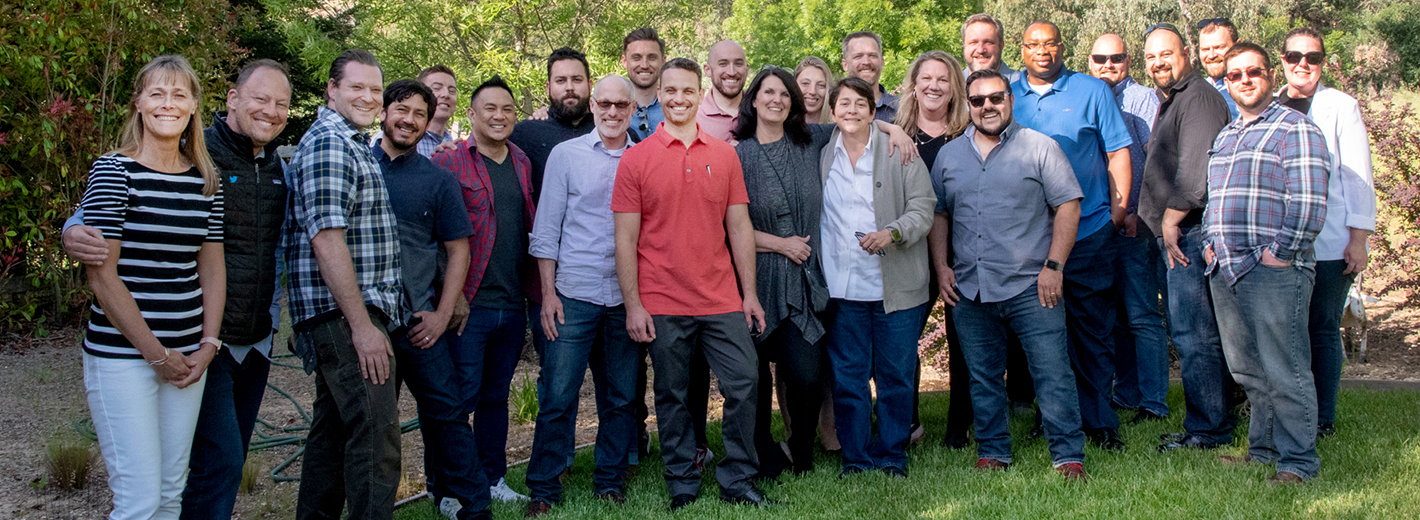
Plant-Forward Champions Gather in Napa to Plan Next Steps
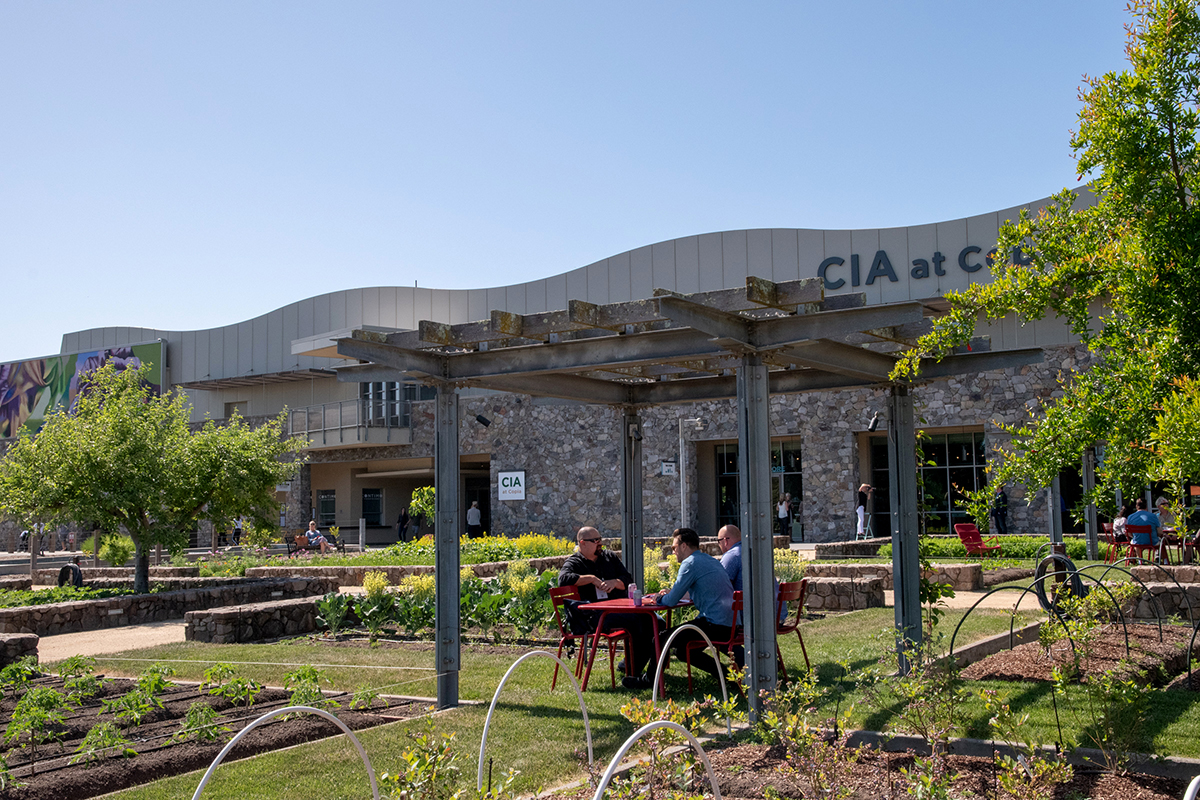
Gates Foundation Executive Chef Paul Rosquita, Uber Executive Chef Ryan Smith, and Expedia Executive Chef Chris Opsata took their group meeting outside
What do you get when you put 18 chefs and members of the Bon Appétit Wellness & Nutrition team together for three days of brainstorming, debating, and cooking? A road map for the company’s plant-forward future — and a memorable feast.
Selected by their regional vice presidents to serve on Bon Appétit’s Plant-Forward Culinary Collaborative (PFCC) working group, the chefs (and one registered dietitian, also a trained chef) hailed from corporate, education, and museum locations around the country. This first meeting of the culinary minds took place at the Culinary Institute of America’s inaugural Plant-Forward Kitchen culinary summit held at Copia, the CIA’s home in Napa, CA.
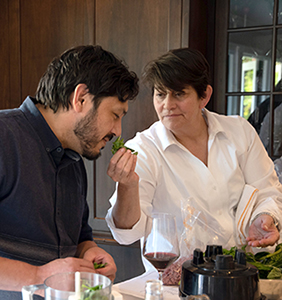
Oath Executive Chef Rogelio Berumen smells fresh mint offered by Southeast Regional Support Executive Chef Kimberly Triplett
Bon Appétit Chief Strategy and Brand Officer Maisie Ganzler kicked off the meeting by asking the PFCC team to dream big and “start a revolution” — explaining that this would not be a static program to pick and choose from; this is a culture shift from within that will touch all parts of Bon Appétit’s business in the future. Then Greg Drescher, CIA’s vice president of strategic initiatives and industry leadership, gave a talk just for the Bon Appétit group, about how the plant-forward movement was growing among leading culinary organizations globally, with a strong focus on looking to and learning from traditionally plant-forward cultures such as those in the Mediterranean.
The CIA’s three-day conference whet the Bon Appétit chefs’ appetites, with presentations by researchers, chefs, and industry thought leaders and culinary trainings inspired by plant-forward cultures around the world, including Israel, Greece, Turkey, Morocco, Nigeria, Cuba, Italy, and Spain. The speakers reminded the audience that these cultures have always built their meals around plants, using local and seasonal produce while focusing on whole-food, plant-based proteins complemented by small amounts of animal protein. Presenters talked about how restaurants from fine dining to progressive fast-casual eateries are evolving to meet Americans’ growing desire for more plant-forward meals. The food service industry, however, is only just beginning to acknowledge this movement, putting Bon Appétit in a good position to lead the charge.
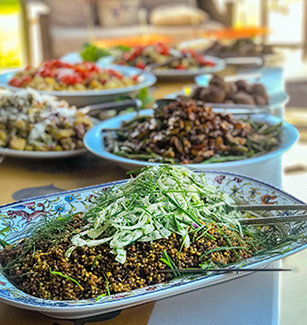
Part of the PFCC feast
Some of the key takeaways from the conference included:
- The importance of treating plants with the same attention and care traditionally given to animal protein found at the center of the plate.
- Use a variety of cooking techniques and flavors to make plants appealing to all types of diners.
- It’s more effective to concentrate on creating craveable dishes that just happen to be mostly plants and skip labeling them as plant-forward, vegan, or vegetarian.
After the conference ended, the PFCC members stayed for a special workshop and brainstorming session led by Director of Wellness & Nutrition Terri Brownlee and Nutrition Project Manager Kristina Todini. They debated how to define what plant-forward means for Bon Appétit — “Forget flexitarian, vegetarian, reducetarian — I’m a flavortarian!” said Nicolai Tuban, an executive chef and Bon Appétit’s Image & Style team’s culinary brand manager.
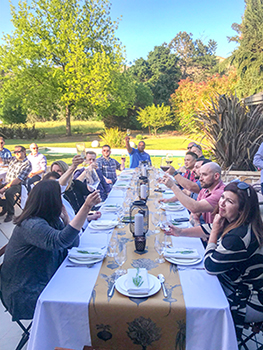
Cheers to a plant-forward future!
Then they broke up into small groups to discuss strategies for creative menuing, educating their staffs (“I want to take them on field trips to restaurants,” said Andrews University Executive Chef Linda Brinegar), communicating with clients and guests, and staying on top of trends, which they then presented to everyone. Kristina recorded all the ideas onto a 20-foot-long idea map she had created to serve as a framework for the discussion.
Finally, it was time for dinner. Everyone shuttled over to a local rental house where Wellness & Nutrition Executive Chefs Shaun Holtgreve and Cheyenne Luck had assembled the ingredients for a plant-forward menu masterminded by Wellness & Nutrition Executive Chef Dean Holliday. The PFCC chefs teamed up to knock out an array of dishes that offered maximum flavor, a few plant-based protein substitutes, and only minimal amounts of meat, eggs, or cheese. The feast was enjoyed outside in the warm Napa dusk at two simple, elegant long tables set by Resident Marketing Director Cara Brechler.
Everyone agreed that the meal was a persuasive proof of concept, and left excited and energized. In the next year, working groups of three to five PFCC chefs will meet monthly with a registered dietitian and chef from the Wellness team, to continue to spread the ideas and best practices generated at the conference.
Plant-Forward Culinary Collaborative Napa MenuGrilled Oysters with oregano-red wine vinaigrette |